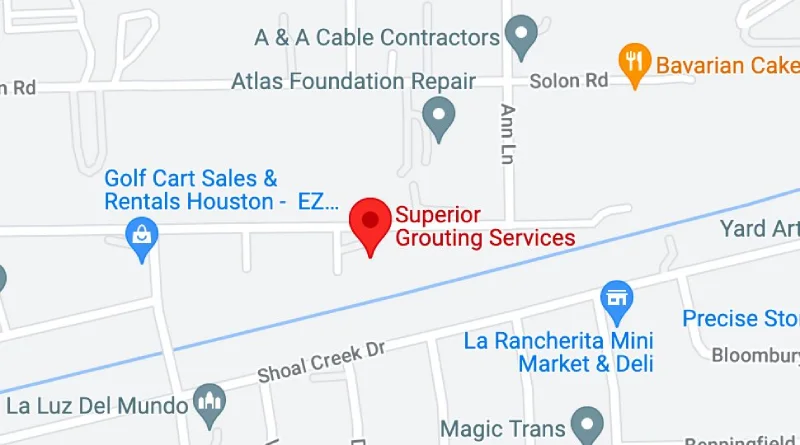How to Evaluate Repair Options for Sunken Warehouse Floors

Evaluating repair options for sunken warehouse floors involves assessing damage severity, identifying subgrade conditions, and selecting between injection-based stabilization, partial slab replacement, or full reconstruction to balance durability, cost, and downtime.
Sunken warehouse floors pose significant operational and safety challenges in industrial environments. Settlement and cracking can affect equipment alignment, forklift stability, and inventory storage safety. Determining the right repair method requires a structured evaluation of the problem, from subgrade integrity to surface deformation, as well as a realistic assessment of operational demands.
Cellular grouting has emerged as a preferred solution for many warehouse floor stabilization projects because it combines the precision of injection-based lifting with the strength and lightweight benefits of engineered cementitious foam. In situations involving deeper voids or extensive soil movement, polyurethane or pressure grouting methods may also be appropriate.
In this guide, we’ll walk through how to assess warehouse floor damage, compare repair techniques, and choose the best industrial-grade stabilization method based on your floor’s load requirements, downtime tolerance, and budget constraints.
Key Takeaways
- Comprehensive assessment drives effective repairs: Evaluating the severity, cause, and depth of warehouse floor settlement ensures the correct balance of cost, downtime, and long-term durability.
- Cellular grouting offers lightweight structural support: Ideal for large slab areas, cellular grout restores uniform subgrade density, fills voids, and stabilizes sunken floors without adding excess weight.
- Injection methods minimize operational disruption: Polyurethane foam and cellular grout allow precision lifting and leveling with minimal downtime, often while warehouse operations continue.
- Full replacement isn’t always required: Only slabs with severe cracking, heaving, or subgrade collapse demand complete demolition and re-pouring.
- Environmental and load factors influence material choice: Temperature, moisture, and live load capacity determine whether to use cellular grout, polyurethane, or conventional concrete replacement.
- Preventive maintenance preserves long-term stability: Routine inspections, drainage improvements, and proper floor load management help prevent recurring settlement issues.
Evaluating Warehouse Floor Damage and Settlement
Before selecting a repair method, it is critical to understand the scope, cause, and severity of the floor’s settlement. Industrial warehouse slabs are typically designed to distribute heavy, repetitive loads, but subgrade failure or void formation can undermine even well-constructed systems. A structured evaluation provides the foundation for selecting the right remediation strategy.
Identifying the Signs of Floor Settlement
Visual and operational indicators often reveal the extent of damage:
- Uneven surfaces: Noticeable slopes or dips affecting pallet jack or forklift operations.
- Cracking or joint separation: Evidence of tension and movement across slab sections.
- Vibration and noise: Hollow or resonant sounds during traffic movement indicate subgrade voids.
- Equipment misalignment: Machinery or shelving foundations appearing tilted or uneven.
- Drainage issues: Water accumulation along slab joints due to uneven settlement.
Inspection and Evaluation Procedures
A professional inspection typically includes:
- Surface elevation mapping: Laser leveling identifies vertical displacement across the warehouse floor.
- Ground Penetrating Radar (GPR): Detects hidden voids or differential density in subgrade materials.
- Core sampling: Confirms slab thickness and subbase composition.
- Load path analysis: Evaluates how weight distribution contributes to localized settlement.
Defining Repair Severity Levels
| Severity Level | Indicators | Typical Cause | Recommended Repair Method |
| Minor | Fine cracks, ¼-inch dips | Slight soil compression | Polyurethane injection or cellular grout |
| Moderate | Visible cracks, uneven sections | Voids, moisture intrusion | Cellular or pressure grouting |
| Severe | Wide cracks, heaving or delamination | Subgrade failure or erosion | Partial replacement with stabilization |
| Extensive | Structural compromise, slab separation | Widespread soil movement | Full slab replacement |
A thorough evaluation prevents misapplication of repair methods, ensuring long-term performance and cost efficiency.
Comparing Repair Methods for Sunken Warehouse Floors
There are several options for addressing floor settlement, each offering distinct advantages depending on operational needs, soil conditions, and budget. Injection-based methods, such as cellular grouting, have become the preferred approach for warehouses requiring rapid, precise, and low-disruption stabilization.
Cellular Grouting for Warehouse Floors
Cellular grouting uses a lightweight, flowable cementitious material that fills voids and densifies subgrade soils. It is especially effective in large warehouse environments due to its ability to flow long distances, penetrate under slab sections, and provide strong but flexible support.
Benefits:
- Distributes loads uniformly without adding significant soil stress.
- Quickly fills voids created by erosion or poor compaction.
- Resistant to moisture and chemical intrusion.
- Compatible with operational environments requiring minimal downtime.
Polyurethane Foam Injection
Polyurethane injection involves pumping a two-part expanding resin under the slab. The foam expands to fill voids and lift the floor gradually.
Advantages:
- Rapid curing—usable in under one hour.
- Precise lift control via pressure monitoring.
- Ideal for small, isolated voids or light-duty slab sections.
Limitations:
- Limited penetration for deep or large voids.
- More expensive on a per-square-foot basis than cellular grout.
Mudjacking (Slurry Pressure Grouting)
Traditional mudjacking uses a mix of cement, sand, and water to lift the slab. Though inexpensive, it adds weight to already unstable soils, often requiring future remediation.
Advantages:
- Cost-effective for minor, non-structural settlement.
- Simple equipment and application process.
Drawbacks:
- Heavy material can exacerbate soil compression.
- Limited flow in narrow or irregular voids.
- Long curing time (1–2 days).
Partial and Full Slab Replacement
When the slab’s structural integrity is compromised, removal and replacement may be necessary.
- Partial replacement: Targeted removal of damaged slab areas, subgrade recompaction, and concrete recasting.
- Full replacement: Used for large-scale failures involving severe cracking, subgrade collapse, or water infiltration.
| Repair Method | Typical Use Case | Curing Time | Disruption Level | Expected Service Life |
| Cellular Grouting | Large, sunken slabs, moderate voids | 12–24 hrs | Minimal | 20+ years |
| Polyurethane Injection | Localized settlement | 30–60 min | Very low | 15–20 years |
| Mudjacking | Light-duty floors | 24–48 hrs | Moderate | 10–15 years |
| Partial Replacement | Structural cracks | 3–5 days | High | 25+ years |
| Full Replacement | Severe structural damage | 7–10 days | Complete shutdown | 30+ years |
Each method provides a different balance of speed, durability, and operational impact. For most warehouse environments requiring fast, reliable results, cellular grouting provides the best performance-to-downtime ratio.
Choosing the Right Repair Method Based on Load, Budget, and Downtime
Selecting the proper repair method for a sunken warehouse floor requires balancing structural needs, operational continuity, and financial constraints. A decision matrix helps engineers and facility managers align the chosen technique with their performance priorities.
Step 1: Define Operational Priorities
Every warehouse operates within unique parameters, and repair solutions must reflect those priorities.
- Load capacity: Heavy storage racking or vehicle traffic may require high-compressive-strength materials.
- Downtime tolerance: Operations with continuous production may favor injection-based repairs over replacements.
- Environmental conditions: High humidity or chemical exposure requires water-resistant or non-reactive grouting materials.
- Budget allocation: Evaluate both immediate repair cost and long-term value, factoring in maintenance frequency.
Step 2: Match Method to Structural Requirements
| Condition | Best Repair Method | Justification |
| Minor settlement with light cracking | Polyurethane injection | Fast curing, minimal disruption |
| Moderate voids, uneven floor sections | Cellular grouting | Lightweight fill, superior coverage |
| Deep voids or subgrade collapse | Pressure grouting or cellular grout | Strengthens base, fills voids fully |
| Severe structural cracking | Partial replacement + grout stabilization | Restores surface and subgrade simultaneously |
| Complete subgrade failure | Full replacement | Required for structural integrity |
Cellular grouting often provides the most balanced solution, delivering reliable structural reinforcement with manageable cost and downtime.
Step 3: Evaluate Cost and Schedule Impacts
| Repair Method | Relative Cost | Typical Project Duration | Operational Downtime |
| Cellular Grouting | $$ | 1–2 days | Minimal |
| Polyurethane Injection | $$$ | <1 day | None–Minimal |
| Mudjacking | $ | 1–3 days | Moderate |
| Partial Replacement | $$$ | 3–5 days | High |
| Full Replacement | $$$$ | 7–10 days | Full shutdown |
Tip: In warehouses with time-sensitive operations, injection-based repairs provide up to 70% faster restoration than replacement, often allowing same-day traffic resumption.
Prevention and Long-Term Maintenance of Warehouse Floors
Repairing a sunken floor is only one step in maintaining long-term stability. Preventive measures and consistent inspections protect the slab from future movement, water intrusion, or load-related stress.
Routine Maintenance Practices
- Inspect annually for cracks, joint widening, or surface settlement.
- Verify drainage and moisture control to prevent subgrade erosion.
- Clean and seal expansion joints to reduce water penetration.
- Monitor load limits—ensure racking systems and forklifts remain within design specifications.
- Maintain coatings or surface sealers to resist chemical and abrasion damage.
Drainage and Environmental Control
- Ensure roof drains and downspouts discharge away from the slab perimeter.
- Grade exterior surfaces to promote positive water flow.
- Maintain vapor barriers under slab-on-grade floors to prevent upward moisture migration.
Monitoring and Predictive Maintenance
Modern warehouses benefit from data-based predictive maintenance programs.
- Laser leveling surveys can track long-term settlement trends.
- GPR inspections detect developing voids early.
- Vibration monitoring helps identify soil compaction under repetitive loads.
| Maintenance Focus | Purpose | Recommended Frequency | Tool or Technique |
| Visual Inspection | Identify surface cracks and dips | Quarterly | Manual walkthrough |
| Elevation Survey | Detect gradual settlement | Annually | Laser level mapping |
| Moisture & Drainage Check | Prevent erosion or washout | Semi-annually | GPR, moisture probe |
| Joint Sealing | Prevent water infiltration | Every 2–3 years | Epoxy or polyurethane sealant |
| Load Verification | Confirm racking safety | Annually | Engineering review |
Implementing these proactive practices helps warehouses maintain smooth, level, and safe working floors while extending the life of concrete infrastructure.
Conclusion
Evaluating repair options for sunken warehouse floors requires more than a quick fix—it demands a structured engineering approach. By carefully assessing damage severity, subgrade integrity, and operational constraints, facility owners can choose the repair method that delivers both immediate stability and long-term performance.
Among available methods, cellular grouting stands out for its balance of precision, cost-efficiency, and minimal disruption. It effectively stabilizes subgrades, fills voids, and restores uniform load distribution without requiring heavy demolition. When combined with preventive maintenance practices such as proper drainage, joint sealing, and annual inspections, cellular grout provides a lasting solution that ensures warehouse floors remain level, safe, and durable.
Superior Grouting’s expertise in large-scale industrial slab stabilization helps facility managers make informed decisions based on real performance data and proven results. From inspection to injection and post-grouting verification, every stage of the process is executed with precision to restore warehouse functionality and reliability faster and more efficiently than traditional methods.

